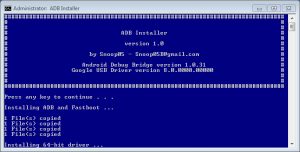
- Easy install adb and fastboot 15 second drivers#
- Easy install adb and fastboot 15 second update#
- Easy install adb and fastboot 15 second driver#
- Easy install adb and fastboot 15 second full#
- Easy install adb and fastboot 15 second android#
We go to RPI’s GIT page (see 12) and see that there are no different versions of bootcode.bin available. We either try different versions of the bootcode.bin files, or we try to change the files that are run by bootcode.bin. Because bootcode.bin is closed-source, we can’t configure it directly so there are 2 things we can do. In this part, the software embedded into the device by the manufacturer runs the bootcode.bin. K5 - Application (Qt QML) K1 - Raspberry boot stage K2 - Linux pre-boot stage (3rd Stage Bootloader) (start.elf, bcm2710-rpi-3-b.dtb) K1 - Raspberry boot stage (1st & 2nd Stage Bootloader) (bootcode.bin) RPI boot process from power-up to Qt application is as the following dtb -> read cmdline.txt -> kernel.img runs

Easy install adb and fastboot 15 second full#
After Kernel runs, we have full control over everything.
Easy install adb and fastboot 15 second driver#
After performing these operations, it’ll keep running on the device as a GPU driver till the device is turned off. dtb file, and run the kernel.img with the parameters in the cmdline.txt file. Its purpose is to split RAM between the GPU and the CPU, apply the settings inside the config.txt file to the GPU, make the necessary adjustments by reading the corresponding.

The boot process of RPI is kind of different from the other, traditional devices. Besides that, optimizations should be done and tested one by one, so that the effect can be seen. We need to be able to answer questions such as what is the boot sequence of the device, which files are running in which order to boot the device, which files are 100% required etc. If you previously installed it at the system level and now want it to be only the current user (or vice versa), it will not remove it, you have to do it yourself.First of all, we should know the target device well since some critical stages of the boot optimization process are low-level (hardware dependent). If you have an older Google USB driver installed, please uninstall it from the Control Panel before installing fresh
Easy install adb and fastboot 15 second update#
If you have a driver enumeration problem in Windows 8.1, install update KB2917929 If the installation fails, post here the contents of “ADB-installer.log” from your desktop. If anyone has trouble detecting the device, go to the images directory and view the attached howto_driver.zip file The installer automatically decides whether to install 32-bit or 64-bit drivers. System-wide: ADB and Fastboot are installed to the %SystemDrive%\adb directory, and a system-wide path is added.Ĭurrent User Only: ADB and Fastboot are installed to the %UserProfile%\adb directory, and a path is added for the current user.ĬMD can use ADB and Fastboot from any directory.ĭrivers are installed on the system – no need to install them from directories.
Easy install adb and fastboot 15 second drivers#
Press Y/Yes to install drivers or N/No to skip.Press Y/Yes to install ADB on a system level or N/No for current user only.Press Y/Yes to install ADB and Fastboot or N/No to skip.Run it (requires administrator privileges).

It is a very small and fast installer of tools and drivers.įast – 15-second install (many times even less)ĪIO – ADB and Fastboot as well as driversĮasy to install – just run it and the program will guide youĬlean – ADB and Google drivers from the latest SDK I saw another ADB installer on XDA, but it wasn’t good enough for me so I finally posted it here. I originally made it for my Kurdish friend AnGrY DuDe in early 2013. No need to download a large SDK for 3 small things. This is an All-in-One installer of 3 essential tools for PC for Android.

Easy install adb and fastboot 15 second android#
Universal ADB Drivers, ADB Driver Installer, Universal Android USB Driver.


 0 kommentar(er)
0 kommentar(er)
